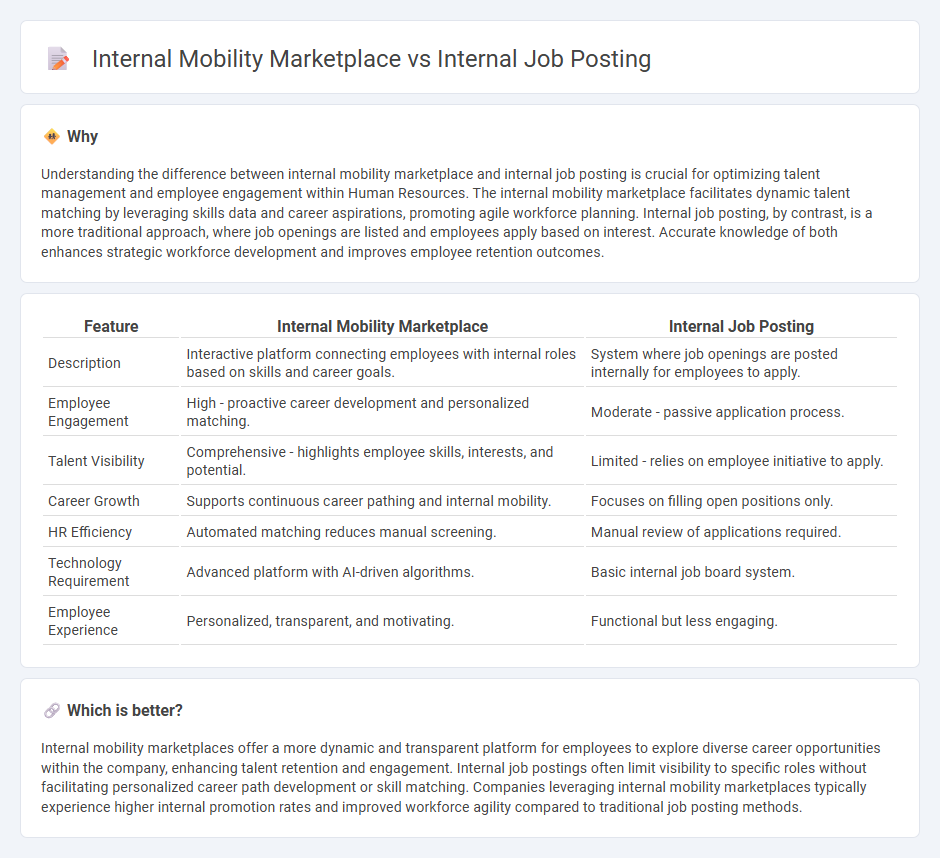
Internal mobility marketplaces streamline talent movement by matching employees with relevant roles based on skills, experience, and career aspirations, surpassing traditional internal job postings that merely list vacancies. These platforms enhance workforce agility, promote employee engagement, and reduce recruitment costs by leveraging existing talent pools strategically. Explore how integrating an internal mobility marketplace can transform your organization's talent management strategy.
Why it is important
Understanding the difference between internal mobility marketplace and internal job posting is crucial for optimizing talent management and employee engagement within Human Resources. The internal mobility marketplace facilitates dynamic talent matching by leveraging skills data and career aspirations, promoting agile workforce planning. Internal job posting, by contrast, is a more traditional approach, where job openings are listed and employees apply based on interest. Accurate knowledge of both enhances strategic workforce development and improves employee retention outcomes.
Comparison Table
| Feature | Internal Mobility Marketplace | Internal Job Posting |
|---|---|---|
| Description | Interactive platform connecting employees with internal roles based on skills and career goals. | System where job openings are posted internally for employees to apply. |
| Employee Engagement | High - proactive career development and personalized matching. | Moderate - passive application process. |
| Talent Visibility | Comprehensive - highlights employee skills, interests, and potential. | Limited - relies on employee initiative to apply. |
| Career Growth | Supports continuous career pathing and internal mobility. | Focuses on filling open positions only. |
| HR Efficiency | Automated matching reduces manual screening. | Manual review of applications required. |
| Technology Requirement | Advanced platform with AI-driven algorithms. | Basic internal job board system. |
| Employee Experience | Personalized, transparent, and motivating. | Functional but less engaging. |
Which is better?
Internal mobility marketplaces offer a more dynamic and transparent platform for employees to explore diverse career opportunities within the company, enhancing talent retention and engagement. Internal job postings often limit visibility to specific roles without facilitating personalized career path development or skill matching. Companies leveraging internal mobility marketplaces typically experience higher internal promotion rates and improved workforce agility compared to traditional job posting methods.
Connection
Internal mobility marketplaces and internal job postings are interconnected tools that drive talent optimization within Human Resources by promoting employee career growth and retention. Internal job postings provide transparent access to available opportunities, while mobility marketplaces facilitate matching employee skills with suitable roles, enhancing workforce agility. Together, they foster a dynamic internal talent ecosystem that reduces recruitment costs and accelerates organizational adaptability.
Key Terms
Job Board
Internal job postings serve as straightforward job boards where current employees can view and apply for open positions within their organization. An internal mobility marketplace expands beyond simple listings by integrating personalized career development tools, skill matching algorithms, and real-time job recommendations to enhance employee engagement and retention. Explore how these platforms can transform your talent management strategy and drive workforce agility.
Career Pathways
Internal job postings offer employees current openings within the organization, enabling straightforward applications for new roles. Internal mobility marketplaces provide a dynamic platform where employees can explore multiple career pathways, access personalized job matches, and receive development insights to advance their growth. Explore how integrating internal mobility marketplaces can transform career pathways and foster talent retention.
Skills Matching
Internal job postings typically list available positions within a company, requiring employees to manually search and apply based on job titles and descriptions. An internal mobility marketplace leverages advanced skills matching algorithms to connect employees with roles aligning closely to their competencies and career aspirations, enhancing talent utilization. Explore how integrating skills matching technology can transform your internal mobility strategy.
Source and External Links
10 Helpful Examples of an Internal Job Posting Template - An internal job posting is a vacancy shared exclusively with current employees, aiming to promote internal career growth, retain talent, and reduce onboarding time by filling roles with those familiar with the company culture.
Improve Your Internal Job Posting Procedures - Internal job postings should clearly state the job title, description, responsibilities, qualifications, and compensation to give employees detailed information to assess their fit before applying.
Internal Job Posting: Everything HR Needs to Know - Writing an internal job posting involves using a clear, concise format similar to external ads, including job title, summary, responsibilities, and ensuring the hiring process is smooth for current employees.
 dowidth.com
dowidth.com